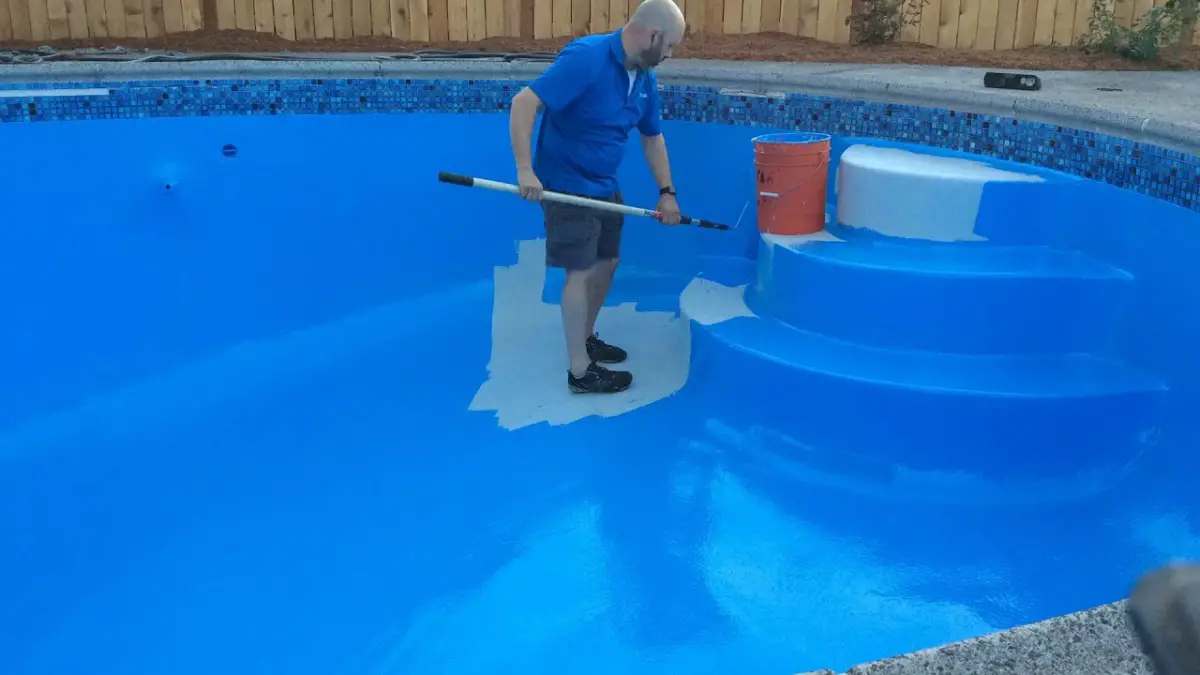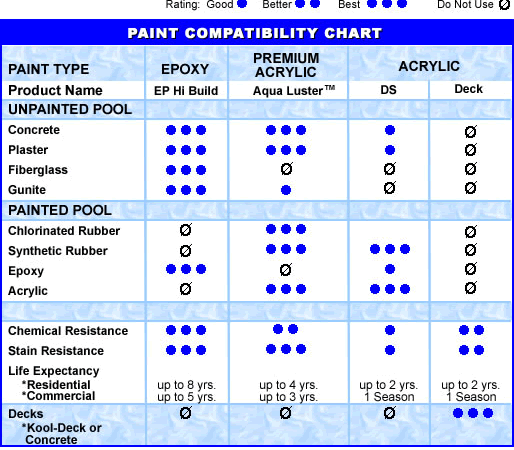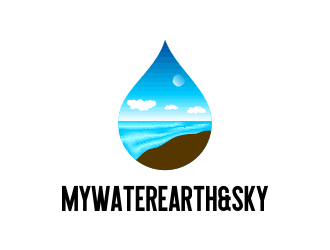Every 5 to 10 years it’s necessary to paint the pool to keep it looking beautiful. To get it done by a professional company would cost an arm and a leg. Using the right type of paint and knowing the importance of prepping the in-ground pool surface, a pool owner can save a lot of money with great results by doing it themselves. Be safe & Never work alone! because any space that is over your head like an Inground Pool is considered a Confined Space where fumes can collect. How to paint an Inground Pool?
- Pick Compatible Paint
- Determine how much paint you’ll need & add extra
- Prep-Remove loose paint-Powerwash
- Never work alone
- Etch inside with Green Muriatic Acid
- Ensure the pool is completely dry
- Use the right tools-Paint in the right Temp
- Dry & Cure for the right time
- Keep H2O chemistry balanced to prevent fading
If you can spend as much time or more on prepping your pool before you paint it, you will be highly successful with the project. If you don’t, it could be a giant waste of Time & Money!
Swimming Pool Paint
If you’re like me and own an inground pool all if most work is done by yourself but painting you’re inground Pool is a big deal. The first thing you need to know is what kind of paint to use. If your pool has been painted before then you should know. Most people will leave a can around for touch up or you can even get a chip sample of it at a paint store.
- There are also a few tests you can try. Take a 1-inch paint chip, and soak it in denatured alcohol. If the chip dissolves, it is a water-based acrylic
- Soak a new chip in 75% mineral spirits and 25% Xylol, wait 30 seconds, and rub the chip between your thumb and forefinger. If it dissolves, the paint is a synthetic rubber-based coating. If not:
- Try soaking one last chip in 100% Xylol.
- If it dissolves, the paint type is chlorinated rubber
- if it does not, it is epoxy.
There are three main types of pool paint currently used – Epoxy, Premium acrylic, and Water-Based Acrylic. Chlorinated rubber paints were once very popular but have been largely phased out due to environmental concerns. Epoxy Pool Paint lasts the longest and seems to be the most popular. It is resistant to stains and abrasions.
Epoxy paint can last up to 8 years and can be used on unpainted surfaces. The surface needs to be prepped and dry. The paint comes in 2 gals. cans. This makes it easy to ship and handle. Each gallon must be individually mixed. The drying time is really important. It can take 5- 7 days for outside pools and 10 14 days for inside pools with the proper ventilation.
Premium Acrylic pool paint is designed to comply with environmental regulations regarding VOCs and replace chlorinated and synthetic rubber-based paints. Acrylic is made to paint directly over unpainted concrete plaster or concrete. It will also work if you painted with acrylic before, you can apply it right over the last paint job.
It can also be applied right over pools that were painted with chlorinated rubber or synthetic rubber. The Acrylic paint needs 5 days to cure(outside) and 7 days for inside pools.
Paint and surface compatibility:
- *If you have an unpainted concrete or plaster pool, epoxy or premium acrylic are the best paint choices.
- *For an unpainted fiberglass or gunite pool, epoxy is recommended.
- *For pools previously painted with synthetic rubber or acrylic paint, your best options are premium acrylic or water-based acrylic.
- *If the surface was painted with chlorinated rubber, premium acrylic would be recommended.
- *Epoxy should be used if the pool was previously painted with epoxy.
How Much Does It Cost To Paint a Pool
I’ve always used Rubber Based Paint until it was suspected of environmental issues but since then was disproved. That stuff was nasty and hard to get on without bubbling and blistering. Once I switched over to epoxy I was sold because of the ease of applying it and how long it lasted.
If you don’t want to paint your pool every 3 or 4 years it makes a lot of sense to use high-quality Epoxy Pool Paint. The secret is prepping. If you prep and apply it right it will last for 7 or 8 years and maybe a little longer. Choosing high-quality paint will be well worth it every time you need to do it.
Use a Pool Paint Calculator and you should be able to nail down how much paint you need. *Big Tip- Get extra you’ll come up short and if you have a little extra left you can always use that extra can down the road 2-3- or 5 years down the road. The step areas of an Inground Pool take a beating and see a lot of traffic and the edges of the steps get cracks in the paint. You can lower the water level to expose these areas and paint them again. The extra paint will come in handy.
The formula is as follows:
(L x W) + (L x Avg Depth x 2) + (W x shallow depth) + (W x deep depth) = Total square footage of surface area of all the pool sides and bottom.
To determine the average depth in a pool where the bottom slopes are: Measure the shallow end and measure the deep end. Add them together and divide by 2. This is the average depth of your pool.
Below is an example using a 16 x 32 pool with a Shallow depth of 4′, a deep depth of 8′, and an average depth of 6′ feet
L x W = (32 x 16) = 512
L x Avg. Depth x 2 = (32 x 6 x 2) = 384
W x Shallow Depth = (16 x 4) = 64
W x Deep Depth = (16 x 8) = 128
512 sqft for the bottom + 384 sqft (the two long sides) + 64 sqft (small side) + 128 sqft (deep side) = 1088 SQFT.
Round off the numbers and pick up an extra gallon. 1200 Square Ft. or 3 cans of this paint.
A quality type of Epoxy Pool Paint like this product INSL-X Products IG4001S99-2K INSL-Guard EPOXY Pool Paint kit purchased through Amazon and enough to do the job should be below $1000.00 dollars.
This product will cover 350 to 400 square ft. INSL-GUARD 2 Gallon Black Pool Epoxy Kit contains a two-component epoxy pool paint with a polyamide epoxy coating specially formulated to resist common pool chemicals ensuring an extremely durable finish and long-lasting results. This product is for painting over Fresh or Saltwater pools as well as with concrete, marcite, gunite, or fiberglass pools but not over Rubber Based or Chlorinated Rubber Based Pool Paint.
Cheaper paint is fine to use but think about it. Do you want to keep adding coats of paint? Do you want to empty the pool in 2 or 3 years and do this again? Add in the price of cleaners and tools to your project. I’ve done this 3 or 4 times in my life. I own a huge old Sylvan Pool that was built in the ’60s and learned a few things.
- Don’t skimp on the prep work
- Don’t skimp on the Price of the Pool Paint
- Don’t skimp on the Drying Time. Please Don’ Skimp On The Drying Time!
How To Remove Old Paint From Swimming Pool
Choose a long weekend with the weather in your favor. You will need a few days to prep it and another few to dry it out after you prep it. Inviting some buddies over for Food and Beer always works for me. The temperature shouldn’t be too hot or too cold. Read the label on the Pool Paint can.
You should be doing this in Sring or Fall so it won’t be interfering with your pool’s season. You want to be able to take your time and get it right. The main idea is not to do this for another 10 years and of course, to make it look really nice and if you do a nice job you will make it look really nice and save a lot of money too.
So plan it well. All sun and No Rain. A few days to Prep and a few days to paint. Open your Pool’s Hydrostatic Valve. It should be located in the deepest part of the pool in the center of Pool’s floor. In fact, now is the time to replace the Valve. They are inexpensive and should be changed every few years. So even if it works swap it out. Make sure that also add a Main Drain Safety Compliant Drain Cover that is mandatory in most States a small price to pay for a child’s life. 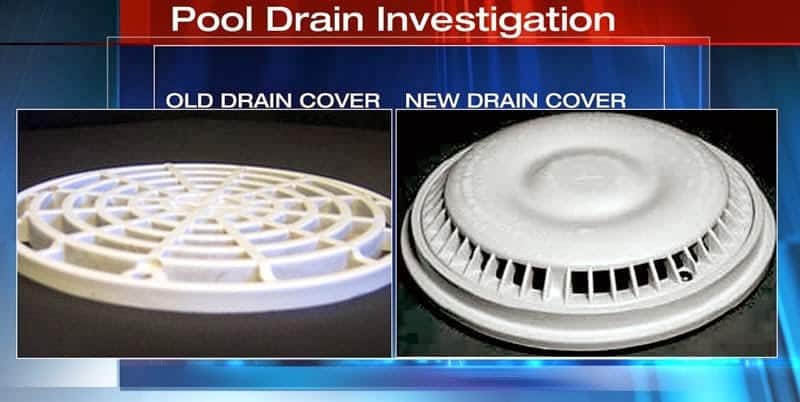
After pumping the pool out: Pick up a Power Washer
Knock all the loose paint and dirt with a hard bristle broom after the pools are pumped out and dry. remove any ladders toys or pool lights, including the main pool light, and pull them out so the Inground Pool is bone empty. Then sweep it out. I use a Pota-Vac and get it all out before things start to get wet.
- Use a Powerwasher with high power to clean the inside of the Inground Pool. You can rent one from the Home Depot or another Home Improvement Center for the weekend and it might cost 100-150.00 dollars.
- Use a Citrus based cleaner with a power washer this needs to be environmentally friendly.
- Attach a 15-degree stripping nozzle to a pressure washer. It’s just enough to knock the old paint off.
- Stand at different angles.
- You don’t have to get everything off the walls. Just the stuff that is chipping and the machine will do fine.
Acid Wash and Etch Your Inground Pool
After you powerwash the Inground pool you’ll need to acid wash the walls and floor with Muriatic Acid. I use 1 gallon of water then add 1 gal. of Green Muriatic Acid. Always use Green Muriatic Acid the same Acid you use to adjust the PH in your Pool Water. You can find it at Pool Supply stores or places like Home Depot. It has 90% fewer fumes than the industrial-strength kind that is dangerous to use.
- Always add acid to water never water to acid
- Use a 2-gallon Chemical Resistant Gardening Can to mix and apply the diluted acid in the pool
- Walk down into the pool and start at the deepest end
- Apply the diluted acid as you walk out of the pool after a good coating let sit work-the longer sits on the wall the better it will work
-
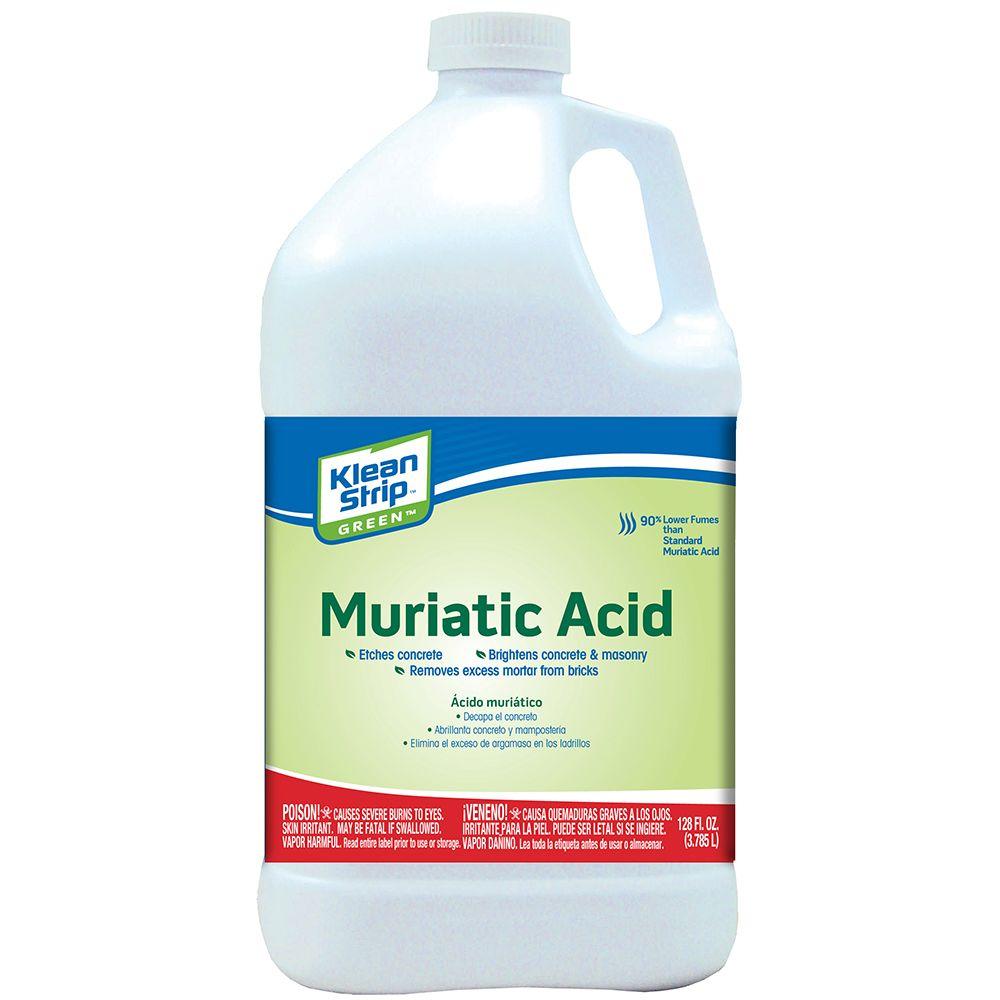
- Rinse with a garden hose
- Apply the diluted acid from the top of the pool wall
- Add it to the top of the wall and let the diluted acid roll down covering the sidewall.
- Let it sit on the wall for a while before you rinse it with the garden hose
- Do one side then the other then rinse with a hose
There is a reaction when you mix the Muriatic acid. It’s nasty stuff so remember that. Once you are in the pool and even if the muriatic acid is diluted it still will make fumes when it reacts with water. Don’t hang around inside the pool come right out after you apply it to the floor of the pool. Never I mean–Never work ALONE!
The Acid will clean oils and algae baked onto the walls and floor. Once you are done etching the inside the pool with the diluted acid, you can give it some time to dry and suck the remainder of the dilution which by this time should be harmless, and suck the remainder up with a Wet-Vac.
How to Paint a Swimming Pool With Epoxy Paint
Make sure there are no puddles or standing water and if so use the Wet-Vac. You don’t want anything wet inside while you paint. Tape off the tile or coping stone, the pool light, ladder holes anything that is chrome or aluminum you don’t paint on. Now your chance. If you are painting your inground Swimming pool with epoxy paint prepare for weather or any scheduling problems. Give yourself some time and help if you can get it.
- Paint the pool with a 3/8 nap roller. A roller with too much nap will shed and you’ll have hairs in the coat that will stay there.
- Pull the Pool Light and ladders out of the Pool before you start
- Start in the deep end of the Inground pool and work your way to the shallow end and out of the pool
- Use an extension pole on your roller for the deep-end walls.
- A bucket & screen is easier to use than a shallow paint pan.
- Mid-morning is the best time to paint after the dew has lifted.
- Do not apply paint if the temperature is below 50 degrees Fahrenheit or above 90 degrees. Extremely humid weather can cause the paint to not adhere. If you are applying the second coat of paint, wait for 4 hours before re-painting, until it’s dry to the touch.
The last step of Curing is the most important step of all. Curing is the time it takes for the pool paint to become durable and harden up. When all the water has evaporated it has created a firm bond with the surface. This information is usually listed on the label on the can. Normally it’s 4-5 days after painting the pool that you start to fill it. If it rains during this curing time then use a leaf blower to move any standing water to where you can sponge or soak it up. Add some curing time if the rain continues.
If you see any blisters in the paint or bubbles what that means is that that part of the Inground pool wasn’t prepped well enough. The paint will blister if there is some moisture underneath that spot. There’s not much to do with it unless you can get below the water line re-prep the area and paint it again.
How Long Does Pool Paint Last
Between the sun and the strong oxidizing chemicals like shock chlorine and granular chlorine, your Inground takes a beating. There are a few things early on after you painted the pool like keeping granular chlorine in the bottom by mixing it first and diluting it before adding it to the water or making sure that Alkalinity levels stay a little high at 100 ppm to 150 ppm.
This will ensure the PH levels stay in range and don’t slip down lower. If they do fresh paint will rub off on hands or feet. So after you fill your freshly painted pool make extra sure the pool water chemistry stays in range.
If you used Epoxy paint the pool paint should last 7 -8 years and up to 10 years if your pool water is consistent. Epoxy paints form a hard, water- and chemical-resistant finish, making them a durable paint choice for swimming pools Properly applied, epoxy paint can last for a long time but if you don’t prep the pool right before you paint well then it won’t matter too much. Over a few years, the paint will fade and chalk making your paint look like it is a lot older than it is.
References:

